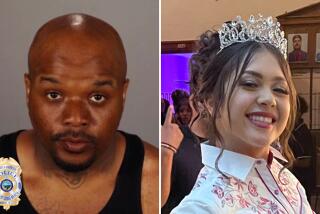San Diego police solve 1984 killing of teen at Torrey Pines State Beach
- Share via
The brutal 1984 killing of a teenager at Torrey Pines State Beach has apparently been solved through DNA and an extensive investigation, the San Diego Police Department announced Thursday.
Both suspects in the strangulation and mutilation of 14-year-old Claire Hough are dead, the police said. Both were linked through DNA.
The teenager was in San Diego visiting her grandparents from her home in Rhode Island when she was found dead.
One of the suspects, Ronald Clyde Tatro, 67, was killed in a boating accident in 2011 in Tennessee. He had an extensive criminal history of sexual assault, according to homicide unit Lt. Paul Rorrison.
The other suspect, Kevin Charles Brown, 62, a retired San Diego Police Department criminologist, was found dead Tuesday at Cuyamaca State Park east of San Diego. His death was ruled a suicide.
Brown had been interviewed and knew he was a suspect in the killing and would soon be arrested, Rorrison said. He had no criminal history and an investigation showed that he had no role in processing evidence from the 1984 crime scene, Rorrison said.
Rorrison declined to discuss any relationship between Tatro and Brown. Brown retired in 2002 after 20 years as a civilian employee with the department.
Police do not consider the 1984 slaying to be linked to a similar crime in 1978, when Barbara Nantais, 15, was killed near the spot at Torrey Pines.
In both the 1978 and 1984 killings, the victim was strangled, sand was pushed into her mouth, and one of her breasts was mutilated, according to news accounts of the two crimes.
Although police are sure that they have identified the killers, they are still asking anyone with information to contact the homicide unit or San Diego County Crime Stoppers (888 580-8477).
In three decades, hundreds of police and other investigators combed the beach, pored through files and conducted interviews for possible leads, Rorrison said.
“Obviously we’re very gratified,” Rorrison said. “It’s what we strive for. We work for the victims and the family. These cases don’t just go away.”
A story in the San Diego Union shortly after the Aug. 24, 1984, killing reflected the paucity of clues at the crime scene. DNA analysis was not available to investigators in those days.
Claire Hough’s grandparents were unclear why she had walked to the beach that night.
“Boredom, perhaps, or the romance of the surf took the attractive teenager the several hundred yards to the beach one night last week,” the newspaper story said. “What the girl from Rhode Island found was death at the hands of someone who strangled her and left her body beneath an Old Highway 101 bridge.”
More to Read
Sign up for Essential California
The most important California stories and recommendations in your inbox every morning.
You may occasionally receive promotional content from the Los Angeles Times.












